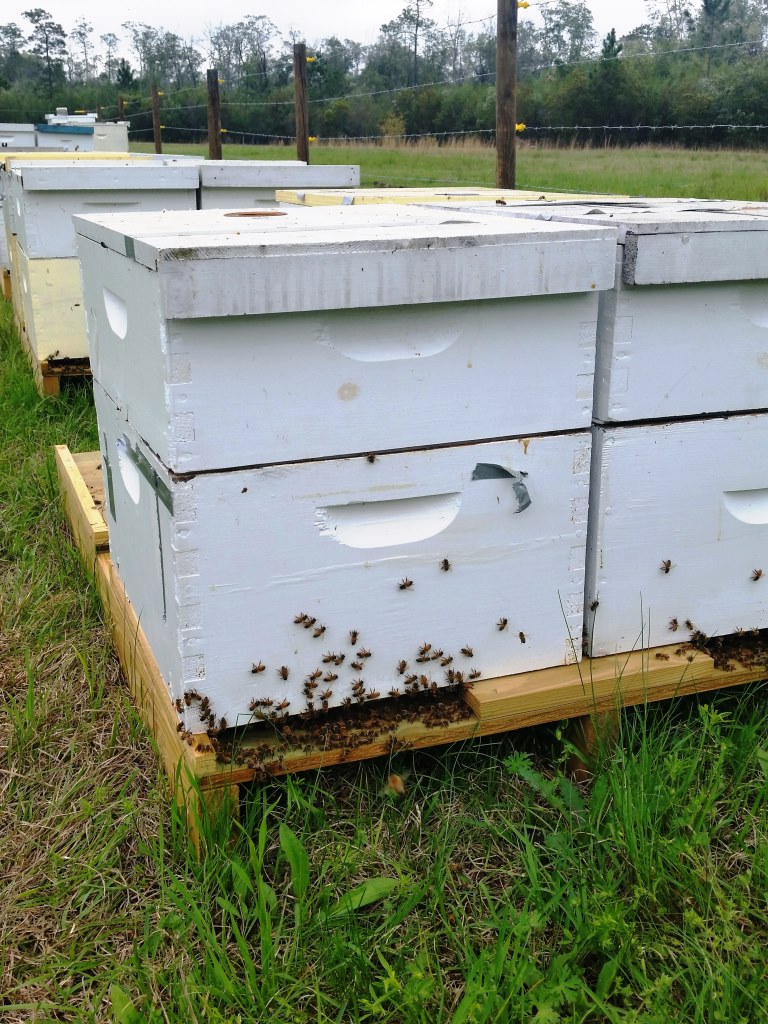
If life were simple, one of its advantages would be that an apiary could be established and the beehives would never have to be moved. But life isn’t simple, and beekeepers need to move their bees for various reasons. They may need to be moved to make a special honey crop such as: sourwood, tupelo, gallberry, cotton, or orange blossom. Bees are moved to pollinate a crops like watermelons, blueberries, almonds, or apples. Even establishing a new apiary may require some type of transportation . Whatever the purpose, there are important steps beekeepers can take to make the move more efficient and less disruptive to the bees.
When you move bees, your goal is to have most, if not all, of the bees stay with you and their hives. Here are a few things to consider before, during, and after the move: Is the move over a short or long distance? How many hives are involved? What time of year do they need to be moved?
The approach to moving one or two hives within an apiary is different than moving a large number of hives several miles or more. The best way to move hives within the apiary is through trial and error. Move the hive a few feet and watch to see if a large number of the hive’s forager bees are returning to the former hive site and flying around the old location instead of entering the hive in the new location. The probable reason for the forager’s confusion is that bees tend to learn the location of their hive based on landmarks they see around the hive. Movement of hives to a new distant location, on the other hand, is actually simpler than moving hives a short distance in that there is less chance of forager loss, if certain precautions are taken.
Whatever distance the bees are moved, they should be prepared for the move unless it is to be in small increments where the beekeeper is manually carrying the hives. All cracks and crevices in the hives should be sealed or closed. The hive bodies and bottom boards should be fastened together using stapling ties. Many beekeepers enclose bees with screens to block the beehive entrance and then move them in the cool of the night. Large apiaries often bypass the screening step in the interest of time and to ensure maximum ventilation. When enclosing bees using entrance screens, be mindful of the weather and length of time the bees are “locked” in the hive as temperature extremes and suffocation can result in loss of bees.
An extra precaution many beekeepers take when moving a large number of hives is to cover the entire load of beehives with some type of netting. This keeps the bees on the truck and reduces the possibility that stinging episodes, and possible liability issues, will occur in route to the new location. Check with your local Florida Department of Agriculture and Consumer Services Apiary Inspector for information on netting and transportation requirements.
The unloading of bees at the new site can be made less stressful on the bees and the beekeepers if a few precautions are taken. Do not turn off the truck engine upon arriving at the site. The engine vibrations will help keep the bees inside their hives as they are being unloaded. If possible, it is best to place the hives in the new location late in the day or at night. This will reduce the tendency of the foragers to fly away from the hive in search of food before they have learned the new location of the hive.
If you are one of the hundreds of new beekeepers in Florida, it is important you learn all you can about beekeeping best management practices, including transportation of the hives. Please see the following resources for more information.
University of Florida IFAS Beekeeping Publications
UF/IFAS Small Farm Enterprises: Beekeeping

Article Sources:
Honey Bees and Beekeeping: A Year in the Life of an Apiary, 3rd Edition – Keith Delaplane, Ph.D. (2007)
Hive Management: A Seasonal Guide for Hive Management – Richard E. Bonney, Blandford Press, (1992)
The Hive and the Honey Bee – Roy A Grout, (1992)
 0
0
